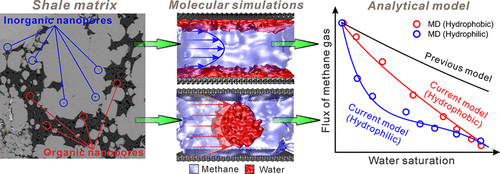当前位置:
X-MOL 学术
›
Energy Fuels
›
论文详情
Our official English website, www.x-mol.net, welcomes your
feedback! (Note: you will need to create a separate account there.)
Two-Phase Transport Characteristic of Shale Gas and Water through Hydrophilic and Hydrophobic Nanopores
Energy & Fuels ( IF 5.2 ) Pub Date : 2020-03-15 , DOI: 10.1021/acs.energyfuels.0c00212 HengYu Xu 1 , Hao Yu 1 , JingCun Fan 1 , YinBo Zhu 1 , FengChao Wang 1 , HengAn Wu 1
Energy & Fuels ( IF 5.2 ) Pub Date : 2020-03-15 , DOI: 10.1021/acs.energyfuels.0c00212 HengYu Xu 1 , Hao Yu 1 , JingCun Fan 1 , YinBo Zhu 1 , FengChao Wang 1 , HengAn Wu 1
Affiliation

|
Previous attempts to characterize shale gas transport in nanopores are not fully successful due to the fact that the presence of water within shale reservoirs is generally overlooked. In addition, shale is known as a wettability-varying (hydrophilic and hydrophobic) rock depending on various components and maturity grades. Herein, toward this end, we performed a comprehensive study about two-phase transport characteristic of shale gas and water through hydrophilic and hydrophobic nanopores by integrating the molecular dynamics (MD) simulations and analytical models. Using MD simulations, we showed that water molecules prefer to accumulate at the walls (water film) in hydrophilic nanopores while form the water cluster at the center region of hydrophobic nanopores, which significantly alters the shale gas transport behavior. For hydrophilic nanopores, the existence of water film weakens the gas–walls collisions (slip effect), resulting in a viscosity dominant transport mechanism. In contrary, shale gas transport in hydrophobic nanopores is mainly contributed by slip effect where the gas–gas collisions (viscosity) is abated by the water cluster. On this basis, we proposed an analytical model to quantitatively depict the shale gas transport behavior in moist nanopores, which is well verified by MD simulations results. Particularly, according to our flow model, the gas transport capacity decreases to only 15% when mixing with 50% water molecules for both hydrophilic and hydrophobic nanopores, which would be greatly overestimated by traditional models neglecting the presence of water molecules. The deep insights gained in this work will further the exploitation and development of shale reservoirs.
中文翻译:

页岩气和水通过亲水和疏水纳米孔的两相输运特征
由于通常忽略了页岩储层中水的存在这一事实,以前描述纳米孔中页岩气运输特征的尝试并未完全成功。此外,根据各种组分和成熟度的不同,页岩被称为可润湿性变化(亲水和疏水)的岩石。为此,我们结合分子动力学(MD)模拟和分析模型,对页岩气和水通过亲水性和疏水性纳米孔的两相输运特性进行了全面研究。使用MD模拟,我们发现水分子更喜欢在亲水性纳米孔的壁(水膜)处积聚,而在疏水性纳米孔的中心区域形成水团簇,这显着改变了页岩气的输运行为。对于亲水性纳米孔,水膜的存在减弱了气壁碰撞(滑动效应),从而导致了粘度主导的传输机制。相反,疏水性纳米孔中的页岩气运输主要是由滑移效应引起的,其中水团簇减弱了气-气碰撞(粘度)。在此基础上,我们提出了一种分析模型,定量描述了潮湿纳米孔中的页岩气运移行为,该模型已通过MD模拟结果得到了很好的验证。特别地,根据我们的流动模型,当与50%的亲水性和疏水性纳米孔的水分子混合时,气体传输能力仅降低至15%,而传统模型忽略了水分子的存在,将大大高估了气体的传输能力。
更新日期:2020-04-23
中文翻译:

页岩气和水通过亲水和疏水纳米孔的两相输运特征
由于通常忽略了页岩储层中水的存在这一事实,以前描述纳米孔中页岩气运输特征的尝试并未完全成功。此外,根据各种组分和成熟度的不同,页岩被称为可润湿性变化(亲水和疏水)的岩石。为此,我们结合分子动力学(MD)模拟和分析模型,对页岩气和水通过亲水性和疏水性纳米孔的两相输运特性进行了全面研究。使用MD模拟,我们发现水分子更喜欢在亲水性纳米孔的壁(水膜)处积聚,而在疏水性纳米孔的中心区域形成水团簇,这显着改变了页岩气的输运行为。对于亲水性纳米孔,水膜的存在减弱了气壁碰撞(滑动效应),从而导致了粘度主导的传输机制。相反,疏水性纳米孔中的页岩气运输主要是由滑移效应引起的,其中水团簇减弱了气-气碰撞(粘度)。在此基础上,我们提出了一种分析模型,定量描述了潮湿纳米孔中的页岩气运移行为,该模型已通过MD模拟结果得到了很好的验证。特别地,根据我们的流动模型,当与50%的亲水性和疏水性纳米孔的水分子混合时,气体传输能力仅降低至15%,而传统模型忽略了水分子的存在,将大大高估了气体的传输能力。











































 京公网安备 11010802027423号
京公网安备 11010802027423号